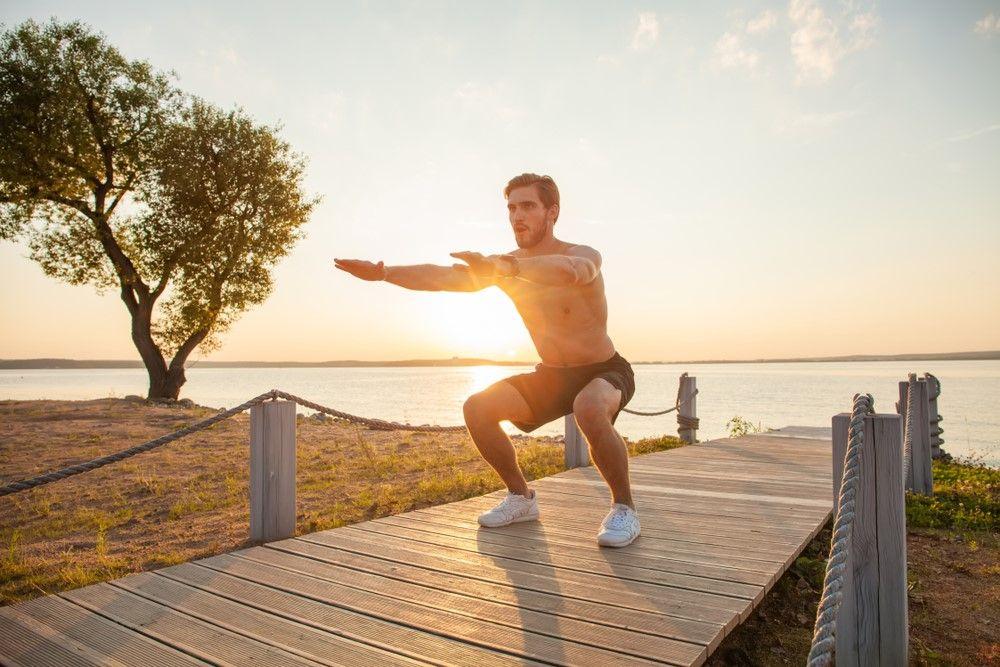
Your Top 10 Strength Exercises
Now that we've covered what strength training can do for you, here are the top ten strength exercises you can try at your local gym, or even at home. Many of them are so simple, that there's really no excuse not to try them out.
1. Squats
Squats are a compound exercise that targets multiple lower body muscles, including quadriceps, hamstrings, glutes, and calves. They mimic the pedaling motion and strengthen the muscles used during cycling. Start with bodyweight squats and gradually progress to weighted squats for added resistance.
2. Deadlifts
Deadlifts target the posterior chain, including the glutes, hamstrings, and lower back. This exercise improves overall power and stability, which is essential for maintaining an efficient and strong cycling posture. Begin with light weights and focus on proper form before gradually increasing the load.
3. Lunges
Lunges engage the quadriceps, hamstrings, and glutes while also challenging your balance and stability. They help correct muscle imbalances and enhance single-leg strength, crucial for climbing hills and sprinting. Perform walking lunges, stationary lunges, or reverse lunges to target different muscle groups.
4. Step-ups
Step-ups simulate the motion of climbing hills and help build strength in the glutes, quadriceps, and hamstrings. They also improve balance and coordination. Use a step, bench, or sturdy box and step up with one leg at a time, alternating between legs.
5. Planks
Planks strengthen the core muscles, including the abs, obliques, and lower back. A strong core provides stability, allowing for efficient power transfer from the upper to the lower body during cycling. Hold a plank position for 30-60 seconds, focusing on maintaining proper alignment and engaging the core muscles.
6. Russian Twists
This exercise targets the obliques and improves rotational strength. It enhances core stability, which is essential for maintaining balance while navigating turns and corners during cycling. Sit on the floor with your knees bent and feet lifted off the ground, then twist your torso from side to side while holding a weight or medicine ball.
7. Leg Press
The leg press machine is excellent for targeting the quadriceps, hamstrings, and glutes. It allows you to lift heavier loads safely, stimulating muscle growth and power development. Adjust the seat and foot position to ensure proper alignment and perform controlled leg presses.
8. Calf Raises
Strong calves are crucial for generating power during the upward phase of the pedal stroke. Calf raises help strengthen the calf muscles and improve ankle stability. Stand on the edge of a step or use a calf raise machine, rise up on your toes, and slowly lower down.
9. Dumbbell Rows
Dumbbell rows work the upper back, shoulders, and arms, which are often neglected in cycling. Strengthening these muscles helps maintain a balanced posture and reduces the risk of shoulder and neck discomfort. Bend forward at the hips, keeping your back straight, and row the dumbbells towards your waist.
10. Glute Bridges
Glute bridges activate the glutes, hamstrings, and lower back. They strengthen the posterior chain and improve hip extension, which is vital for generating power during each pedal stroke. Lie on your back with your knees bent, lift your hips off the ground, and squeeze your glutes at the top of the movement.

Nuances and Things to Avoid in Strength Training
Despite the numerous benefits of strength training, it's essential to approach it with care and consider certain nuances. Here are some key points to keep in mind:
Periodization
Just like with cycling training plans, you should incorporate periodization into your strength training plan. Periodization involves dividing the training program into specific phases, such as hypertrophy, strength, and power. Each phase focuses on different training goals and intensities, allowing for proper recovery and adaptation. Consulting with a coach or trainer who specializes in cycling can help you create an effective periodized strength training plan.
Functional Movements
Emphasize functional movements that mimic the cycling motion and engage multiple muscle groups simultaneously. While isolation exercises can be beneficial for targeting specific muscle imbalances or weaknesses, prioritize compound exercises that promote overall strength and coordination. Functional movements like squats, deadlifts, lunges, and step-ups closely resemble the muscle activation patterns used during cycling.
Proper Form and Technique
Ensure that you perform each exercise with proper form and technique. Incorrect form can lead to injuries or ineffective training. If you're new to strength training, consider working with a qualified trainer who can teach you the correct techniques and provide feedback on your form. Focus on maintaining a neutral spine, engaging the appropriate muscles, and moving through a full range of motion.
Gradual Progression
Start with lighter weights and gradually increase the load as your strength and technique improve. Avoid the temptation to lift heavy weights right from the start, as it can increase the risk of injury. Progressive overload is key to stimulating muscle growth and strength gains. Monitor your progress, track your weights, and aim to gradually increase the resistance over time.
Recovery and Rest Days
Strength training places stress on the muscles and requires adequate recovery for adaptation and growth. Allow for rest days between strength training sessions to give your muscles time to repair and rebuild. This also helps prevent overuse injuries and promotes overall recovery. Balancing strength training with cycling workouts and rest days is essential for achieving optimal results.
Individualization
Each cyclist has unique strengths, weaknesses, and goals. It's important to tailor your strength training program to your specific needs and limitations. Assess your current fitness level, identify any muscular imbalances, and focus on exercises that address those areas. If you have any pre-existing injuries or medical conditions, consult with a healthcare professional or physical therapist to ensure that your strength training program is safe and appropriate for you.
Avoid Excessive Training Volume
While strength training is beneficial, avoid excessive volume or frequency that could interfere with your cycling performance or recovery. Balance your strength training sessions with your cycling workouts to prevent excessive fatigue. Remember, cycling remains the primary focus, and strength training should complement and support your cycling goals.

Final remarks
Integrating strength training into your cycling routine is a wise investment that will yield remarkable benefits. By engaging in exercises that target the major muscle groups used in cycling, you can enhance your power, prevent injuries, improve endurance, and enhance your overall cycling efficiency. However, it's important to approach strength training with care, considering nuances such as periodization, functional movements, proper form, gradual progression, recovery, individualization, and avoiding excessive training volume. Remember to listen to your body, consult with professionals when you’re not sure, and enjoy the journey of becoming a stronger and healthier version of yourself.
Sources:
- Ronnestad et al., 2019, "Optimal Exercise Modes to Target Lower-Body Power in Recreational Cyclists.
- Buckeridge et al., 2018, "Effectiveness of Strength Training on Musculoskeletal Injuries in Recreational Cyclists: A Systematic Review.
- Turner et al., 2016, "Strength Training for Endurance Performance: Integration of Physiological and Biomechanical Concepts.
- Sandbakk et al., 2018, "The Physiological and Biomechanical Factors Contributing to Enhanced Endurance Performance in Nordic Skiing Compared with Running.
- Kelley et al., 2019, "Effects of High-Intensity Resistance Training on Bone Mineral Density in Young and Older Adults: A Systematic Review and Meta-Analysis.













